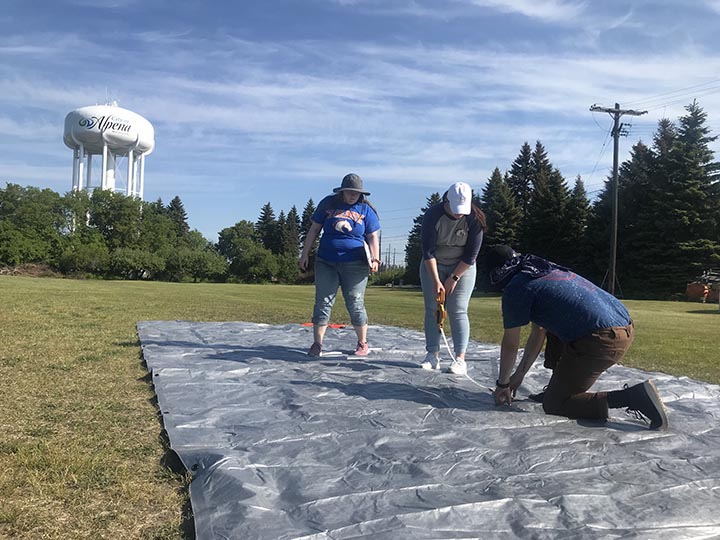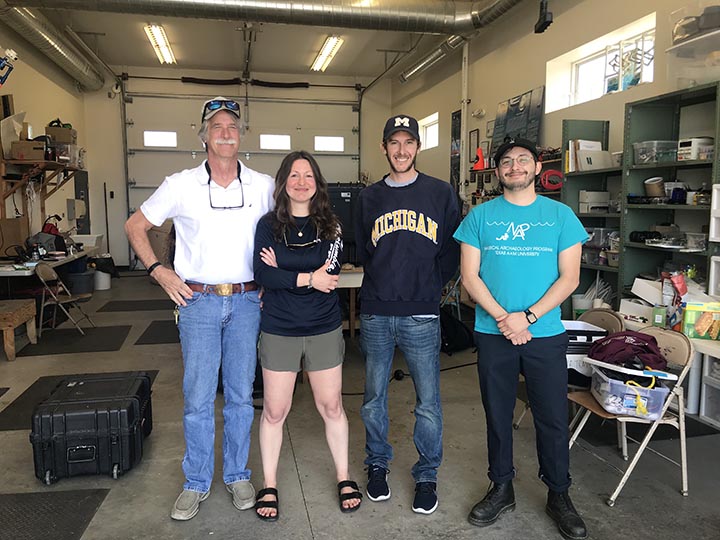
By Darby Hinkley, The Alpena News
This article is part of a collaboration between The Alpena News and Great Lakes Now at Detroit Public Television to bring audiences stories about the Great Lakes, especially Lake Huron and its watershed.
ALPENA — A trio of researchers who have been studying the Alpena-Amberley Ridge are joined this month by a group of undergraduate students from the University of Texas at Arlington. The college students will be learning the ins and outs of maritime archaeology. They started their field school Tuesday and it runs through June 15.
The trio of researchers include John O’Shea, curator of Great Lakes Archaeology at the Museum of Anthropological Archaeology at the University of Michigan, Dr. Ashley Lemke, assistant professor of anthropology at the University of Texas at Arlington, and teaching assistant Brendan Nash, Ph.D. candidate at the University of Michigan.

From left to right are John O’Shea, curator of Great Lakes Archaeology at the Museum of Anthropological Archaeology at the University of Michigan, Dr. Ashley Lemke, assistant professor of anthropology at the University of Texas at Arlington, and teaching assistants Brendan Nash, Ph.D. candidate at the University of Michigan, and Michael “River” Rivera, M.S. candidate at Texas A&M University. (Photo by Darby Hinkley/The Alpena News)
“The three of us have been working up here for a number of years,” Lemke said. “We’ve been working out in the middle of the sanctuary, looking for about 9,000-year-old archaeological sites.”
The Alpena-Amberley Ridge, deep water in the middle of Lake Huron, is at the center of their research.
She said they are looking for small stone tools, hunting structures, and other artifacts that provide clues into the lives of early Lake Huron inhabitants.
“For me, as a professor, it’s a really great place, and a really great opportunity to bring students so they get to see how to do underwater archaeology in one of the best places there is to do it,” Lemke said. “There are so many shipwrecks, and it’s beautiful here, and they have all these different kinds of archaeological sites — really old ones and really recent ones.”
Lemke is from Washington state, but she got her master’s degree and her Ph.D. from the University of Michigan.
Joining the three are eight undergraduate students from the University of Texas at Arlington, along with a second teaching assistant, Michael “River” Rivera, M.S. candidate at Texas A&M University.
“They’re all kind of at different stages in their undergraduate career,” Lemke said of the students. “They’re anthropology majors who are interested in doing archaeology. So they’re kind of getting their feet wet for the first time, and seeing what it’s like.”
Anthropology is defined as “the study of human beings and their ancestors through time and space and in relation to physical character, environmental and social relations, and culture,” according to Merriam-Webster.com. Archaeology is defined as “the scientific study of material remains (such as tools, pottery, jewelry, stone walls, and monuments) of past human life and activities.”
Lemke explained what the students will be doing during the field school.
“During that time, they’re going to go out on a research vessel, they’re going to learn how to use side-scan sonar,” she noted, referring to a type of sonar system that is used to map and create images of large areas of the sea floor.
On Tuesday, the students built their own ROVs, or remotely operated vehicles. On Wednesday, they mapped out a mock shipwreck on a tarp on the back lawn behind the National Oceanic and Atmospheric Administration (NOAA) building near the Great Lakes Maritime Heritage Center.

Jonathan Villanueva of Arlington had never been to the Great Lakes before this trip. Here, he holds the ROV he made on Tuesday. (Photo by Darby Hinkley/The Alpena News)
“We are measuring out a shipwreck here so we can scale it down to size to make a scale model with the right proportions,” said Kelsey Deweese, an undergraduate student in the program.
Then they reduced the measurements by 1/20th to create hand-drawn maps on graph paper.
“We are taking measurements and making a 1/20th scale diagram, so there’s a lot of geometry involved,” Nash explained.
Arlington, Texas, is in between Dallas and Fort Worth.
“It’s in north Texas, right in the middle of a super urban area,” Lemke noted. “So it’s big. We call it an urban research institution.”
Many of these students have never been to any of the Great Lakes.
“This is a really interesting thing because these kids are coming up here from Texas to experience fresh lake water as opposed to the Gulf Coast,” O’Shea said.
Jonathan Villanueva of Arlington had never been to the Great Lakes before this trip.
“It’s really cool,” he said, adding that he was looking forward to going out on the boat to see the shipwrecks.
Lemke explained why the Thunder Bay National Marine Sanctuary is an ideal locale for underwater research.
“I think it’s really telling that a bunch of undergrads came from Texas all the way up here, because for me to teach them how to do underwater archaeology, this is the best place in the country to do it,” Lemke said. “Because of the shipwrecks. There are so many. They’re really close to shore. They’re really accessible. They’re not really deep.”
She said it’s the perfect way for the students to sample maritime archaeology to see if they want to continue with a career in that field.
“None of them are diving, and they’re still going to be able to learn all this,” Lemke said.
The Thunder Bay National Marine Sanctuary is NOAA’s only freshwater sanctuary, and is home to an estimated 200 shipwrecks. Ninety-nine have been identified, and archaeologists estimate there are another 100 out there yet to find, according to Stephanie Gandulla, maritime archeologist with TBNMS.
“The preservation is amazing because it’s fresh water, the number of wrecks, the diversity of the shipwrecks that are here,” Lemke continued. “And then, for me, too, the work we’ve been doing is this really old, prehistoric caribou, stone-age hunters, and no one thought that would be out here.”
Obsidian was found at one of the sites in the Thunder Bay National Marine Sanctuary, and it was sourced back to Oregon.
“It’s a volcanic glass you can source really easily,” Lemke said of obsidian, which they found in 2013 but identified recently. “Obsidian, because it’s glass, it’s so good for stone tools, it’s so sharp, so people, in the past, would trade it around all over the place.”
Catch more news on Great Lakes Now:
Great Lakes Sanctuaries: Two more National Marine Sanctuaries in the region see the finish line
Shipwreck Life: How fish and other aquatic species utilize Great Lakes shipwrecks
“Dream Big”: Diving the five lakes in 24 hours, from the perspective of one of the divers
API key not valid. Please pass a valid API key.Featured image: Above, from left to right, Kelsey Deweese, Erin Kielty and Michael “River” Rivera measure out a “shipwreck” so they can scale it down to size to make a scale model with the correct proportions. (Photo by Darby Hinkley/The Alpena News)




